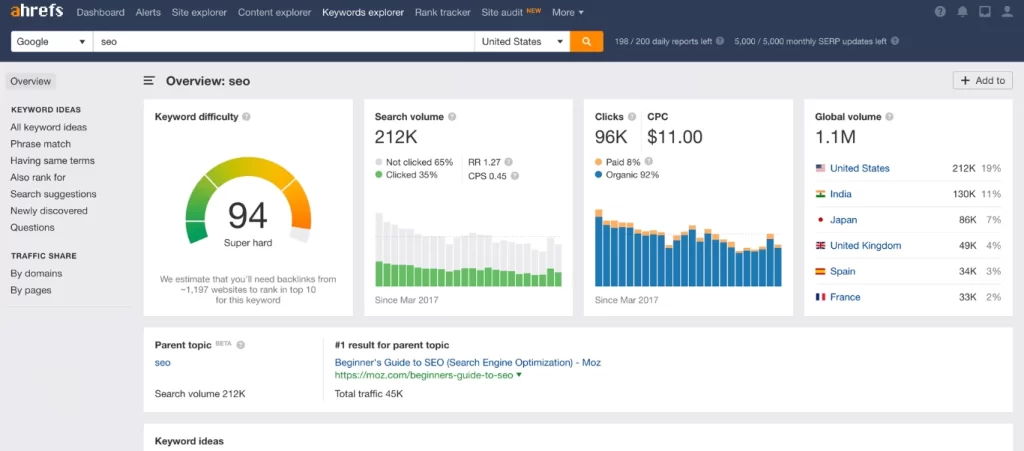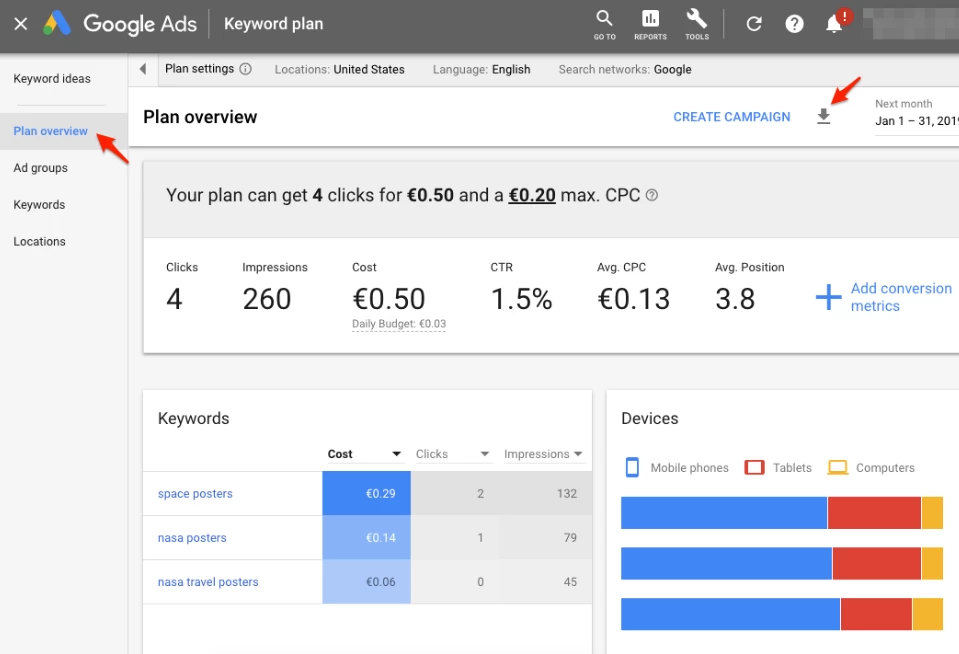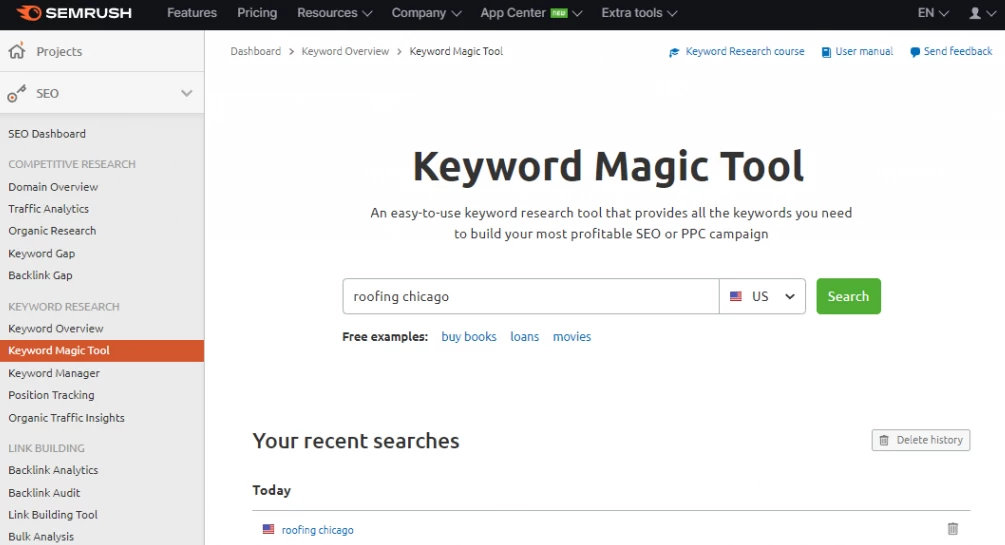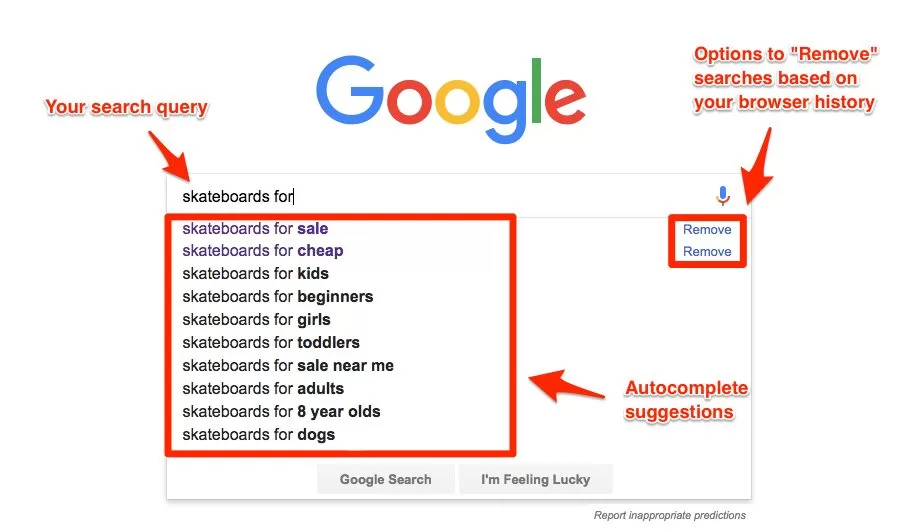Last Updated on 2 years ago by Gülenber Han
Focusing on long-tail keywords is an SEO strategy. Long-tail keywords are those that are more particular – and generally longer – than more regularly used keywords. Long-tail keywords receive less search traffic but have a better conversion value since they are more precise. They enable you to steadily increase traffic to your website and get discovered by new and interested audiences.
When compared to single-word searches, long-tail keywords often have lower search volume, lesser competition, and lower CPCs. The greater conversion chance is because a long tail term is more specialized and easier to comprehend why someone is searching for it, as compared to attempting to guess the multiple reasons behind a query with large monthly search traffic.
As a result, a marketing landing page may more precisely target a long-tail term. In terms of SEO, prioritizing longer, more precise search phrases makes it simpler to develop a website’s authority to eventually rank for larger keywords with more search volume and prospective visitors. To learn how to use such keywords more effectively, you can review our ultimate guide and work with an SEO agency.
What Are Long-Tail Keywords?

Long-tail keywords are lengthier search phrases with extremely specialized search intent (usually three or more words). These keywords have lower search numbers because they are more unique. These keywords have greater conversion rates since they are more focused.
Short-tail keywords are search phrases that are less than three words long and have a broader search intent. These keywords have larger search volumes and lower conversion rates since they are more general.
A long-tail keyword is a phrase consisting of three to five words. Because these keywords are more particular than general phrases, you may target certain populations. Because they are meant to better represent how individuals make searches, these keywords are also less competitive than generic keywords. Long-tail keywords allow you to attract more high-quality visitors to your website, which is more likely to convert.
Long-tail keywords become increasingly significant as the consumer journey progresses. Users often begin with a simple search, and as the search engines assist them in resolving their problems, their queries get more sophisticated. Long-tail keywords will become increasingly significant in differentiating your brand from the competition.
How Do Long-Tail Keywords Work?
Consider this: if you offer vintage furniture, chances are your pages will never show at the top of an organic search for ‘furniture’ since there is too much competition (this is especially true if you are a smaller firm or a startup). However, if you specialize in, say, modern art-deco furniture, keywords like ‘contemporary Art Deco-influenced semi-circle lounge’ would consistently bring you customers who are seeking just that product. Managing long-tail keywords is just a question of improving communication between your company and the clients who are already out there looking for what you have to offer.
Consider this: what are the chances that if you google the phrase ‘sofa’ (a very wide keyword commonly referred to as a ‘head term’), you’ll wind up clicking through to a sale? But if you google ‘elmwood veneer day-bed,’ you’ll find precisely what you’re searching for and are probably willing to pay for it right away. You’ll get less traffic from a long-tail term than from a more prevalent one, but the traffic you do get will be better: more focused, more devoted, and more interested in your services.
Long-Tail Keyword Examples
Depending on the themes your site provides content for and the number of pages you have, you will want to compile a fairly significant list of relevant long-tail keywords that you may employ throughout your site. It’s neither feasible nor SEO-friendly to optimize your site for the same keywords on every page, so have a rolling list of great keywords handy.
If you’re a local business aiming for traffic, using ‘near me’ in your long-tail keywords is a fantastic strategy. Long-tail keywords such as ‘organic coffee cafes near me’ or ‘buy Guiana chestnut plant near me’ are both fantastic instances of when a consumer is at the end of their customer journey and looking via long-tail queries.
For example, the broad search phrase ‘running shoes’ can also be addressed. Examples of long-tail keywords for this general phrase include:
- Best women’s running shoes
- The best long-distance running shoes of 2022
- The best flat-soled running shoes
- Trail running shoes on the road
- Running shoes for arthritic knees
Why Long-Tail Keywords Are Key to Boosting Traffic?
Long tail keywords are used in more than 70% of search inquiries. This is becoming increasingly common as individuals use voice search more frequently. People now often submit inquiries to Google with the same wording they use when communicating with a buddy. This is known as natural language. Using long tail keywords, your content is more likely to pull these people inside your website and start the buyer’s journey.
Because long tail-keywords are made up of a few words, they are significantly more specialized. This implies that both users and site owners will get better outcomes in general. Customers are also pleased when they receive content that is more closely aligned with their goals.
Because long tail-keywords are more specialized, there is less competition for each keyword phrase. Brands can better tailor their unique keywords for the services they deliver to their customers.
You are more likely to get people interested in your site, product, or service if you target long-tail keywords rather than head keywords. This is why:
-
Easier to Rank
You’ve probably seen that Google can now meet highly specific search intentions. It can display a short video segment as a distinct search result, and index passages, and do a lot with highlighted snippets and other SERP upgrades. Long-tail keywords are used in all of these aspects.
Because frequent head keywords are broader, there is a lot of competition and outcomes. A single search query can yield billions of results. However, for a more specific long-tail term, there may be millions of hits. For example, the phrase ‘sushi’ yields 876 million search results, but ‘vegan sushi restaurant Chicago’ yields just 7.4 million. Lower search results indicate less competition, making it easier to rank your content.
-
Targets The Audience Better
The search query of a user can help us establish whether the search is navigational, commercial, transactional, or informative. Because long-tail keywords are more precise and less competitive, someone who looks for one is likely to be ready to make a purchase or commitment.
Someone searching for a broad term, on the other hand, may be conducting preliminary keyword research or assessing all of their alternatives. But, more than likely, they already know what they want; all they need to do now is discover it. The second of the two users is the one you want on your site, and search intent can assist you in identifying how to target the individual with your long-tail keyword.
-
Less Competition = Lower Costs
Everyone wants a piece of the high-traffic SERPs, therefore short-tail keywords are extremely competitive. However, because they are so competitive, only the most authoritative websites can rank on page one. Competing for short-tail keywords may be a waste of time if you are not a large industry leader. Yes, your keywords are searched hundreds of times each month, but what good is that if all of that traffic is going to your competitors?
Long-tail keywords will also help you get more bang for your advertising money if you utilize Google Ads. The cost per click for competitive keywords is often high. Keywords with a smaller search volume or competition, on the other hand, are less expensive and more focused, giving you a better chance of conversion. In a nutshell, fewer competitive keywords simply lower ad spend and higher ROI.
How to Find the Right Long-Tail Keywords?
First and foremost, if you want to sell something, you must have a solid product. Furthermore, you should be fully informed of what your product or website can provide your target audience. What distinguishes your product or blog? If you know and grasp this, it will be a lot simpler to persuade your target audience to enjoy and purchase your products. So, spend some time considering the distinctiveness of your product or blog and write it down.
-
Know Your Unique Selling Proposition
Begin by considering your business to locate keywords that will pay off for you. Ask yourself the following questions:
- What distinguishes your product or service as particularly desired or useful?
- What kind of folks require what you have to offer?
- Why should they pick you over your rivals?
When selecting long-tail keywords, keep these distinct advantages in mind. Your keywords should ideally showcase what you do well and how you distinguish from the competition.
These elements will assist you in reaching consumers who require what you are selling. Remember that the more unusual the search query, the fewer visitors there will be. However, it is the conversions that are important.
-
Determine What Your Target Audience Needs
Your potential clients have needs and desires, and you should determine those needs and desires before proceeding.
- What questions must they answer?
- What are people’s aches and pains?
- What are the solutions that people require that you can provide?
- What factors do individuals examine before investing in what you have to offer?
Often, your sales staff will be able to answer these questions for you. Anyone in your organization who has contact with consumers or clients has the information you may use. Before going on to the most important step: keyword research, make a list of responses to these questions.
-
Keyword Research
So you understand your USP, your clients, and their requirements and desires. Following that, you must do research to ensure that the terms you would use to reach out to potential clients are the same ones they would use in an inquiry. Keyword research might help you identify relevant words that you may not have considered before. It can also aid in the discovery of keyword variants used by your rivals.
-
User Intent
Long-tail keywords give you a never-ending supply of ideas for relevant landing pages and content production to aid in your natural search efforts. After you’ve created a list of long-tail keywords to employ, go through it again. Consider why such terms are searched for.
- What are they trying to discover?
- At what stage of the purchasing process are they?
When you employ your keyword on your site, make sure your content is relevant to those users.
Don’t employ long-tail keywords that aren’t a good fit, even if you believe they’ll be simple to rank for. For example, don’t produce a blog post that corresponds to a search query for ‘make iced coffee at home and then develop content that just discusses your coffee product. When visitors arrive at your site, they will be irritated if your site or product does not meet their wants or answer their inquiries. Understanding search intent might be useful in this situation.
Long-Tail Keywords Finding Tools
Now that you understand the benefits of long-tail keywords and how to search for them, you’ll need the necessary tools to begin analyzing keywords. Many keyword tool alternatives are available to help you locate lists of long-tail keywords in your niche.
-
Ahrefs’ Keywords Explorer

This tool does not need any tiresome physical labor. Simply enter any phrase that describes your specialty into Keywords Explorer and filter by search volume to view hundreds of long-tail keywords.
If your website is brand new and has little ‘authority,’ it is proposed to use the KD filter to identify the least competitive keywords. Also, don’t forget to use the ‘Questions’ button. It frequently yields some interesting long-tail search searches that are presented as questions.
-
Semrush Topic Research Tool

You may use the Topic Research Tool to search for a long-tail term, and the tool will return a list of related topics and content in various forms. You may utilize the information provided here to generate further long-tail ideas.
-
Google Ads Keyword Planner

Keyword Planner in your Google Ads account gives you two options: ‘Discover new keywords’ and ‘Get search volume and projections.’
You will receive more data and information if you have a premium Google Ads account than if you have a free account. More information is available here.
You can obtain insights into different search phrases and see the anticipated amount of clicks and impressions you may acquire if you run advertisements with these keywords using the two choices.
When employing keyword research, you may search for phrases and brands, select a domain to use as a filter, and use additional filters to narrow down your search for long-tail keyword ideas even more.
This program will produce a keyword list for you. It also informs you how much competition there is for each term on Google Ads and how much you can anticipate pay-per-click.
Even if you do not intend to conduct a Google Ads campaign, this provides you with an excellent indication of the value of each term and how tough it will be to rank for each keyword in organic results. The best place to start is via Google’s Keyword Planner.
-
Keyword Gap Tool

You may use this tool to add your domain and enter up to four rivals at the same time. The tool will show you the keywords you rank for and where they rank in the SERPs.
You will also see terms for which your rivals have developed content that you may have forgotten about. This utility includes the Semrush keyword manager. It allows you to add any term you discover to a list that you may use later.
Then, your marketing team may go over these keywords and pick which ones to employ in campaigns.
-
Semrush Keyword Magic Tool

You may use the Keyword Magic Tool to enter keywords and choose your country. Semrush will provide a list of keywords from which you may filter for broad, phrase, precise, or related keywords.
You may also add individual keywords to your keyword manager, which is a wonderful way to keep track of all the phrases you wish to monitor or employ. You may also export the list’s keywords to Excel.
-
Google Autosuggest

When you start entering something into Google’s search box, a drop-down list of terms that people look for appears. Increase the number of long-tail options by adding more words to your search phrase. You may also use a letter to view various autocomplete terms after your search query.
-
Google’s People Also Ask Feature
People Also Ask is a Google-rich snippet feature that presents consumers with additional information related to their first inquiry. Searching for ‘how to start a garden’ is an example of this. The questions that appear in the People Also Ask results are queries that are related to your initial search. Some questions include ‘which month should you start a garden?’ ‘how much does it cost to start a garden?’ and ‘what is the simplest food to grow?’ All of these inquiries are about getting started with a garden for the first time.
-
Use the Related Search Terms Feature
Try looking for a head keyword or one of your long-tail keywords and seeing what related searches Google provides at the bottom of the page.
For example, if you search for ‘content marketing for companies,’ you might also want to include related keywords such as ‘small company content’ or ‘explain why content marketing works.’
-
Boards, Forums, and Social Media
Pay attention to the questions people ask on message boards and forums about your issue. Consider borrowing full queries or phrases related to your long-tail keywords.
A search for content marketing on Quora, for example, may prompt you to utilize the long-tail keywords ‘beginning blunders in content marketing’ and ‘examples of corporate marketing.’
Using Long-Tail Keywords Effectively
Your mission statement, in which you clearly state the magnificence of your product, site, or blog, should be important in selecting the long-tail keywords you want to rank for. The words you selected to define your objective are ideal for focusing on your SEO approach. These terms should be prominent among the long-tail keywords for which you want your website to rank.
You’ve already finished the first phase of your keyword research by writing out your objective. The following step is to compile a list of keywords. Try to put yourself in the shoes of your audience. What will these individuals be looking for? What search phrases will they use to find your product or website? Identifying your core topic and head keywords will most likely be simple, but finding your long-tail keywords may be more difficult.
Once you’ve decided on your keywords, you must employ them appropriately. While this is a topic worthy of its essay, here are a few pointers to get you started with your new keywords.
- Make use of your keywords naturally: Some keywords may be difficult to utilize in a phrase, therefore you may need to be creative with punctuation or change your term somewhat. The user may be turned off if the keyword is misused in the text.
- Place your keywords with care: Include your long-tail keywords and variations in the title, headers, and subheaders of your page if possible. Include it in your opening paragraph, ideally in the first sentence.
- Don’t compromise on utility or readability: Don’t be concerned if your keyword does not match someplace, such as a header. It is preferable to maintain your writing as natural and grammatically correct than to cram a keyword where it will stand out like a sore thumb. Use your keyword where possible, but don’t jeopardize the utility and readability of your article.
- Consider the Search Intent of a user: If you are unsure whether your content is answering the user’s query, some tools and a content marketing agency can help you evaluate the user’s search intent so you can better match the queries.












